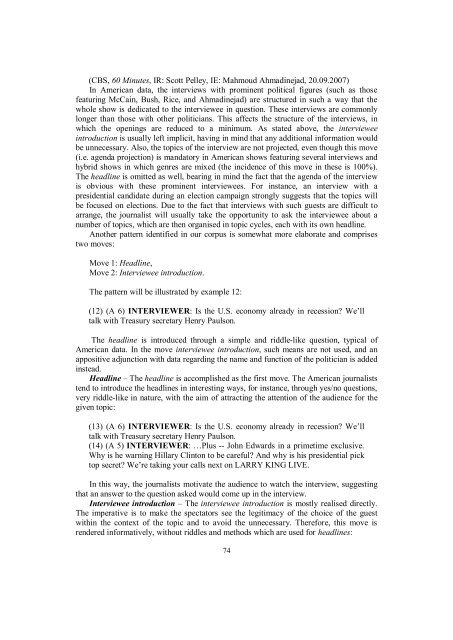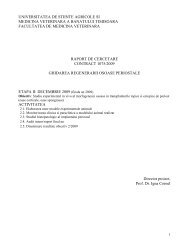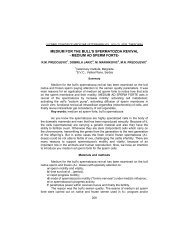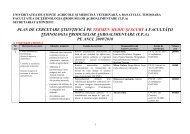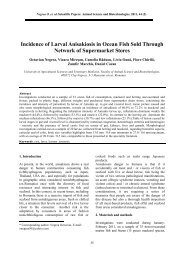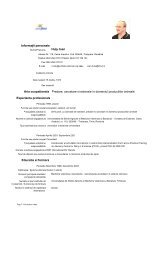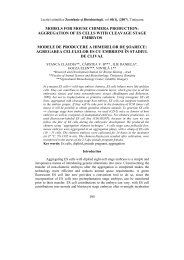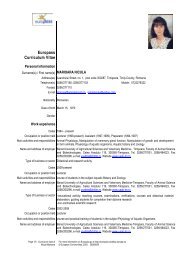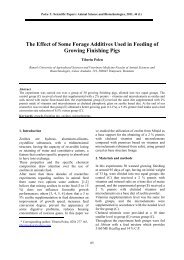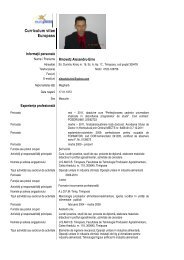journal of linguistic studies
journal of linguistic studies
journal of linguistic studies
You also want an ePaper? Increase the reach of your titles
YUMPU automatically turns print PDFs into web optimized ePapers that Google loves.
(CBS, 60 Minutes, IR: Scott Pelley, IE: Mahmoud Ahmadinejad, 20.09.2007)<br />
In American data, the interviews with prominent political figures (such as those<br />
featuring McCain, Bush, Rice, and Ahmadinejad) are structured in such a way that the<br />
whole show is dedicated to the interviewee in question. These interviews are commonly<br />
longer than those with other politicians. This affects the structure <strong>of</strong> the interviews, in<br />
which the openings are reduced to a minimum. As stated above, the interviewee<br />
introduction is usually left implicit, having in mind that any additional information would<br />
be unnecessary. Also, the topics <strong>of</strong> the interview are not projected, even though this move<br />
(i.e. agenda projection) is mandatory in American shows featuring several interviews and<br />
hybrid shows in which genres are mixed (the incidence <strong>of</strong> this move in these is 100%).<br />
The headline is omitted as well, bearing in mind the fact that the agenda <strong>of</strong> the interview<br />
is obvious with these prominent interviewees. For instance, an interview with a<br />
presidential candidate during an election campaign strongly suggests that the topics will<br />
be focused on elections. Due to the fact that interviews with such guests are difficult to<br />
arrange, the <strong>journal</strong>ist will usually take the opportunity to ask the interviewee about a<br />
number <strong>of</strong> topics, which are then organised in topic cycles, each with its own headline.<br />
Another pattern identified in our corpus is somewhat more elaborate and comprises<br />
two moves:<br />
Move 1: Headline,<br />
Move 2: Interviewee introduction.<br />
The pattern will be illustrated by example 12:<br />
(12) (A 6) INTERVIEWER: Is the U.S. economy already in recession? We’ll<br />
talk with Treasury secretary Henry Paulson.<br />
The headline is introduced through a simple and riddle-like question, typical <strong>of</strong><br />
American data. In the move interviewee introduction, such means are not used, and an<br />
appositive adjunction with data regarding the name and function <strong>of</strong> the politician is added<br />
instead.<br />
Headline – The headline is accomplished as the first move. The American <strong>journal</strong>ists<br />
tend to introduce the headlines in interesting ways, for instance, through yes/no questions,<br />
very riddle-like in nature, with the aim <strong>of</strong> attracting the attention <strong>of</strong> the audience for the<br />
given topic:<br />
(13) (A 6) INTERVIEWER: Is the U.S. economy already in recession? We’ll<br />
talk with Treasury secretary Henry Paulson.<br />
(14) (A 5) INTERVIEWER: …Plus -- John Edwards in a primetime exclusive.<br />
Why is he warning Hillary Clinton to be careful? And why is his presidential pick<br />
top secret? We’re taking your calls next on LARRY KING LIVE.<br />
In this way, the <strong>journal</strong>ists motivate the audience to watch the interview, suggesting<br />
that an answer to the question asked would come up in the interview.<br />
Interviewee introduction – The interviewee introduction is mostly realised directly.<br />
The imperative is to make the spectators see the legitimacy <strong>of</strong> the choice <strong>of</strong> the guest<br />
within the context <strong>of</strong> the topic and to avoid the unnecessary. Therefore, this move is<br />
rendered informatively, without riddles and methods which are used for headlines:<br />
74


